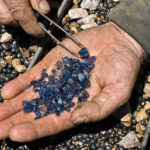
Tenacity | The Miners of Great Falls
Life under the Big Sky has always been an adventure, and no one would know that better than a miner working for the Boston and Montana Consolidated Copper and Silver Mining Company in Great Falls in the late 1800s. Montana’s first mining, smelting, and refining company added to, and dramatically altered, the Great Falls landscape.
 In 1887, 2 years before Montana was granted statehood, railroads owned by Great Northern connected Great Falls with Helena and Butte, and building a smelter to refine the raw minerals extracted from Butte in Great Falls allowed for increased production. The smelter that became known as the Big Stack was located on a bluff overlooking Black Eagle Dam. By 1890, more than 1,000 workers were employed at the smelter. Many of these workers were recent immigrants from nations from around the world including Italy, Croatia, Yugoslavia, Czechoslovakia, Greece, and Norway. These men settled into what were then shanty towns and shacks along the Missouri. As the planned city of Great Falls grew, the miners became an integral part of Great Falls and its history. The nearby community of Belt was home to 500 residents that worked in quarries that shipped limestone by rail to Great Falls.
In 1887, 2 years before Montana was granted statehood, railroads owned by Great Northern connected Great Falls with Helena and Butte, and building a smelter to refine the raw minerals extracted from Butte in Great Falls allowed for increased production. The smelter that became known as the Big Stack was located on a bluff overlooking Black Eagle Dam. By 1890, more than 1,000 workers were employed at the smelter. Many of these workers were recent immigrants from nations from around the world including Italy, Croatia, Yugoslavia, Czechoslovakia, Greece, and Norway. These men settled into what were then shanty towns and shacks along the Missouri. As the planned city of Great Falls grew, the miners became an integral part of Great Falls and its history. The nearby community of Belt was home to 500 residents that worked in quarries that shipped limestone by rail to Great Falls.
For more than 80 years, the Big Stack dominated the Great Falls landscape, and the community of Black Eagle sprung up around the smelter. Life Under the Big Stack contributed to electrifying Montana, civilizing the West, and helping America win World Wars 1 and 2.
The legacy of mining in Great Falls is a thriving city that celebrates its blue-collar roots. That unapologetic spirit is alive and well today in the descendants of the miners that helped build Great Falls. Today, our community celebrates rich cultural diversity not expected in a Montana city. Two restaurants in Black Eagle, 3D International and Borries, exemplify the diversity and cultural heritage miners brought to Great Falls. Both restaurants use the same old-world recipes enjoyed by patrons for over 70 years.
 Today, visitors to Great Falls marvel at a premiere outdoor recreation area once powered by mining. The 1,450-acre Sluice Boxes State Park boasts rugged hiking, fishing, and dramatic landscapes. In the park are the remains of century-old homesteads from mining camps. The park’s central feature are 9,000-foot peaks where Belt Creek flows. The creek traverses a colorful landscape of rolling hills, cottonwood valleys, and enters Belt, MT; home to Harvest Moon Brewery. Between Belt and the Sluice Boxes, much of the creek disappears into the limestone, feeding one of the largest artesian aquifers in the country.
Today, visitors to Great Falls marvel at a premiere outdoor recreation area once powered by mining. The 1,450-acre Sluice Boxes State Park boasts rugged hiking, fishing, and dramatic landscapes. In the park are the remains of century-old homesteads from mining camps. The park’s central feature are 9,000-foot peaks where Belt Creek flows. The creek traverses a colorful landscape of rolling hills, cottonwood valleys, and enters Belt, MT; home to Harvest Moon Brewery. Between Belt and the Sluice Boxes, much of the creek disappears into the limestone, feeding one of the largest artesian aquifers in the country.
Explore the mining history of Great Falls using the River’s Edge History Tour map. This map will show you the sites along the Missouri River in Great Falls that helped the community become an industrial powerhouse during the 20th century. This map will also show you where the Black Eagle Dam continues to provide power to the city, giving Great Falls its nickname of the Electric City!







